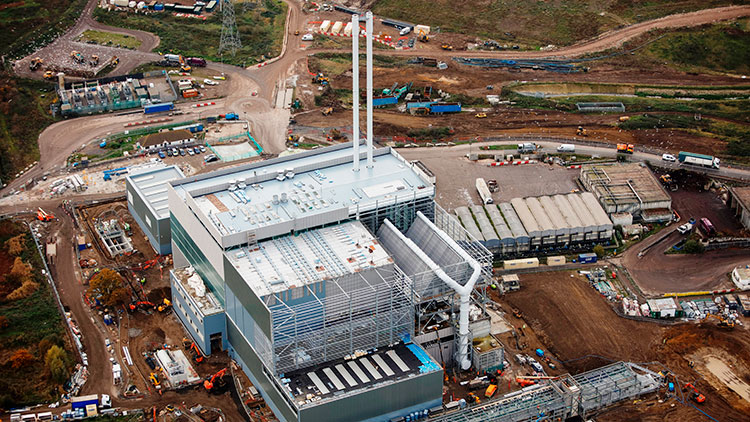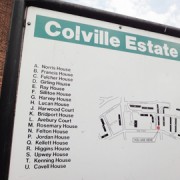
Beddington Lane Incinerator. Pic: Viridor
By Aidila Razak and Emma Snaith
Campaigners are warning that air pollution in the Croydon area could soon rise to dangerous levels after the controversial Beddington Lane incinerator begins its testing process this month.
Despite fierce opposition from environmental groups and the Green Party, Sutton Council granted permission for the waste incinerator to be built at the Beddington site near the Croydon border in 2014.
The incinerator will burn up to 302,000 tonnes of non-recyclable waste from Sutton, Croydon, Merton and Kingston. The energy created will be distributed to neighbouring homes in the form of heat and electricity.
Campaigners from Stop The Incinerator have criticised the “toxic emissions” the plant will generate and the damaging effect this will have on the health of local residents in the surrounding areas.
Shasha Khan, the former Green Party candidate for Croydon North who led the legal challenge against the incinerator, said:
“The incinerator is the wrong solution for the waste in South London. There is not enough waste and it has negative impact on recycling as we are obliged to provide waste to feed it. Finally, at a time when we are acutely aware of the damage that poor air quality causes to Londoners, this incinerator will negatively affect the health of people downwind.”
The commissioning process for the Beddington incinerator will begin this month with each component tested to ensure it is operating correctly and within emission limits. Full operations will begin in the summer.
The website Plume Plotter has developed a real time model which predicts the direction of the emissions from the Beddington Incinerator when it begins its initial operations. Several posts show the emissions travelling across Croydon.
Latest South London incinerator plume plot, 10:53 12/12/17 #ThorntonHeath #UpperSydenham #Norbury https://t.co/Dzzuh82Ngg pic.twitter.com/T4QAfx9Ebm
— Plume Plotter (@plumeplotter) December 12, 2017
Latest South London incinerator plume plot, 17:38 11/12/17 #Beddington #Waddon #SouthCroydon https://t.co/Dzzuh82Ngg pic.twitter.com/3y0S2rUHv1
— Plume Plotter (@plumeplotter) December 11, 2017
Air pollution figures in Beddington shot up to extreme levels in the last week of November due to roadworks and salting activities, with winds believed having blown the pollution across the border to Croydon.
King’s College’s air pollution monitoring group, London Air, found PM10 particulate readings shot up to 420 microgram per cubic metre at Beddington Lane North on Nov 26 and 240 microgram per cubic metre the next day. This is categorised as “very high” by London Air.
The World Health Organisation standard for PM10 exposure is an average of 50 microgram per cubic metre in a 24 hour period.
PM10 are particles smaller than 10 micrometres which can settle in the airway and deep in the lungs to cause health problems.
The UK Without Incineration Network (UKWIN) campaign group believe that is likely that during the commissioning process, emissions from the incinerator will be “unusually high”.
They refer to a 2005 report on waste incineration by Dr. Adam Bostock published on the government’s Environment Agency website. The report says:
“Rigorous monitoring and enforcement is indeed required to ensure that breaches of emission limits are prevented. Enforcement may not be working as rigorously as it needs to be to guarantee protection of health and the environment”
The plant operator Viridor has assured residents living in the surrounding area that the emissions during the testing process of the incinerator adhere to strict environmental regulations.
A Viridor spokesman said: “All tests will be carried out safely and securely. As part of the commissioning process the facility will burn waste for the first time. The Beddington Energy Recovery Facility is regulated by a stringent Environmental Permit, monitored by the Environment Agency.”
“Recovering energy from residual waste is a proven and safe technology with hundreds of facilities operational across Europe,” they added.
But Sutton and Croydon Green Party co-chairman Peter Underwood said this is little assurance, especially with already high pollution levels recorded in the area.
Underwood said: “Croydon residents face a real threat from the incinerator as the prevailing winds in this area is from the west and south-west, blowing the pollution over Croydon and yet the council is contributing to the problem by sending our waste to the incinerator”
Councillor Stuart King, Croydon’s Cabinet member for Transport and Environment said that the council is already taking sufficient measures to address air pollution.
“Croydon council recently approved its new five-year air quality action plan to tackle pollution, with a wide range of measures including a reduction in the use of diesel engines and consulting on extending Croydon’s smoke-free zone across the borough,” he said.




